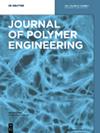N- 丙烯酸-丙烯酰胺共聚物软纳米水凝胶的合成、流变学、细胞毒性和抗菌研究
IF 1.7
4区 工程技术
Q4 POLYMER SCIENCE
引用次数: 0
摘要
水凝胶具有出色的生物特性,是生物医学应用的理想选择。由于水凝胶在有水的情况下会膨胀,因此与活细胞和组织相容。在本研究中,我们研究了水凝胶的稳定性和生物相容性。我们合成并鉴定了 N-丙烯酰甘氨酸(NAG)单体,然后利用微型乳液聚合技术(一种软水凝胶方法)合成了其共聚物。为了确认干燥水凝胶颗粒的形态特性,我们使用了场发射扫描电子显微镜(FESEM)技术。我们还研究了不同浓度水凝胶的流变特性,以评估其机械强度和凝胶状特性。我们的研究结果表明,与其他浓度的凝胶相比,10% 的凝胶在所有检测温度(30 °C、37 °C、40 °C)下都具有更高的强度和屈服应力。我们使用三种不同的细胞系系统地评估了水凝胶的生物相容性:HEK 293T、RAW 264.7 和 HeLa。我们的细胞系研究表明,水凝胶在浓度为 0.5 毫克/毫升时是可以存活的。此外,在浓度低于 0.25 毫克/毫升时也能观察到细胞增殖。MTT 试验和流变学结果表明,水凝胶的特性更适合药物输送和组织工程等各种生物医学应用。本文章由计算机程序翻译,如有差异,请以英文原文为准。
Synthesis, rheology, cytotoxicity and antibacterial studies of N-acrolylglycine-acrylamide copolymer soft nano hydrogel
Hydrogels possess excellent biological properties that make them ideal for biomedical applications. They are compatible with living cells and tissues because they can swell in the presence of water. In this study, we investigated the stability and biocompatibility of hydrogels. We synthesized and characterized N-acryl glycine (NAG) monomer and then synthesized its copolymer using the miniemulsion-polymerization technique, a soft-hydrogel method. To confirm the morphological properties of the dried hydrogel particles, we used the field emission scanning electron microscopy (FESEM) technique. We also investigated the rheological properties of the hydrogels for different concentrations to evaluate their mechanical strength and gel-like properties. Our findings indicated that the 10 % gel had superior strength and yield strain at all examined temperatures (30 °C, 37 °C, and 40 °C) compared to other concentrated gels. We systematically evaluated the biocompatibility of the hydrogel using three different cell lines: HEK 293T, RAW 264.7, and HeLa. Our cell line studies demonstrated that hydrogels are viable when exposed to a concentration of 0.5 mg/mL. Moreover, cell proliferation was observed at concentrations below 0.25 mg/mL. The MTT assay and rheology results suggest that hydrogel characteristics are more suitable for various biomedical applications, such as drug delivery and tissue engineering.
求助全文
通过发布文献求助,成功后即可免费获取论文全文。
去求助
来源期刊

Journal of Polymer Engineering
工程技术-高分子科学
CiteScore
3.20
自引率
5.00%
发文量
95
审稿时长
2.5 months
期刊介绍:
Journal of Polymer Engineering publishes reviews, original basic and applied research contributions as well as recent technological developments in polymer engineering. Polymer engineering is a strongly interdisciplinary field and papers published by the journal may span areas such as polymer physics, polymer processing and engineering of polymer-based materials and their applications. The editors and the publisher are committed to high quality standards and rapid handling of the peer review and publication processes.
 求助内容:
求助内容: 应助结果提醒方式:
应助结果提醒方式:


